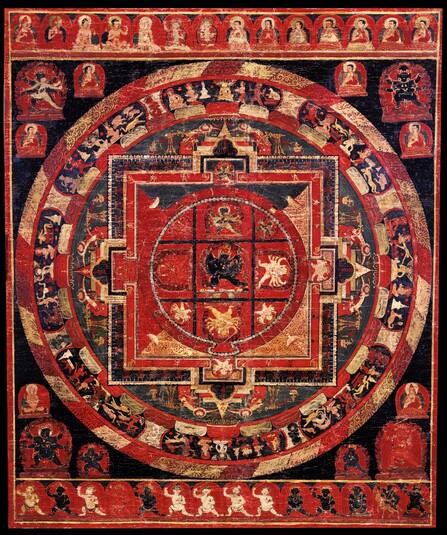
Item: Mandala of Vajrabhairava (Buddhist Deity) - with consort
| Origin Location | Tibet |
|---|---|
| Date Range | 1300 - 1399 |
| Lineages | Sakya |
| Material | Ground Mineral Pigment, Fine Gold Line on Cotton |
| Collection | Navin Kumar |
Classification: Deity
Appearance: Animal-Feature
Gender: Male
Vajra Bhairava 13 Deity Mandala. (Tibetan: dorje jig-je lha chu sum khyil kor).
Within the center of the two dimensional circular diagram (mandala) representing the top view of a three dimensional celestial palace and surroundings is the deity Vajra Bhairava, dark blue in colour, with 9 faces, 34 hands holding a variety of objects, and 16 legs trampling on various animals, birds and gods. The first pair of hands embrace the consort Vajra Vetali (Tib.: ro lang ma. Eng.: Zombie), with one face and two hands holding a curved knife and skullcup, standing on the left leg with the right embracing Bhairava. They are both adorned with bone ornaments and stand atop a lotus within the flames of pristine awareness.
Surrounding the central figures are eight pairs of Bhairavas of various colours, each with multiple faces and hands. At the four ?T? shaped doors stand four pairs of guardian figures. Each pair of figures is counted as one and makes a total of 13 mandala deities.
The floor of the celestial palace is divided into four colours ornately patterned with floral designs: red, blue, white and yellow. On the red veranda outside of the palace walls, on each side of the four doors, are two dancing offering goddesses, sixteen in total. The outer red and white lines forming a square enclosure represent the stylized decorative facade on the four sides of the palace roof. The elaborate lintels above each of the four doors are constructed of tiered multi-coloured steps topped with a Dharma wheel, two reclining deer and gold spires; with a silk canopy above.
Surrounding the palace is a circle of multi-coloured, rectangular shaped, lotus petals (Skt.: padmavali) representing the enormous lotus upon which the entire palace structure rests. The outer circle, divided into eight sections, containing small figures and objects is the ring of the eight great charnel grounds filled with corpses, fires, caityas, yogis, nagas, and wrathful worldly deities. All of that is surrounded by a circle of gold vajras (Skt.: vajravali) on a red background and finally by a ring of multi-coloured fire (Skt.: jvalavali) of pristine awareness completely enveloping the Bhairava Mandala.
Along the top are the lineage gurus of Vajra Bhairava practice. Starting slightly to the left of center with buddha Vajradhara and alternating to the left and right.
Lineage: Vajra Bhairava, Vajra Vetali, mahasiddha Lalitavajra, mahasiddha Vajrasana Amoghavajra, Jnanakaragupta, mahasiddha Padmavajra, Nepali Bharo Chagdum, Rwa Lotsawa Dorje Drag, Rwa Lotsawa Chorab, Rwa Yeshe Sengge, Rwa Bum Seng, Jetsun Gvalo Namgyal Dorje, Serongpa Sherab Sengge, etc. (From Gvalo and his students arose many lineages).
On the outside of the mandala circle starting at the left is Krishna (black) Yamari with three faces and six hands embracing a white consort. On the right is Six Faced (Tib.: Dong Drug) Krishna Yamari with six hands. At the Bottom left is Buffalo faced Bhairava with six hands. At the right is Rakta Yamari, red, with one face and two hands. The upper two deities have a seated lama to either side and the lower two have a lama above and a Bhairava figure below. Along the bottom, from the left, is a row of 11 wrathful protector deities specific to Vajra Bhairava, each with one face and two hands. To the right of those is Panjarnata Mahakala, black, with one face and two hands and Mahakali, (Tib.: Palden Lhamo), balck, with one face and four hands, riding a brown mule. At the right corner is Yama Dharmaraja, the uncommon protector for the cycle of Vajra Bhairava practice. He has the head of a buffalo, black, with two hands holding a bone stick and a lasso; standing above a buffalo.
Shri Bhairava, practiced in all the Sarma Schools, is a tutelary deity of the method (father) class of Anuttarayoga Tantra. From the many Yamari Tantras, and forms of the deity, this representation is from the Bhairava Root Tantra (Tib.: jig-je tsa gyu).
The style of the painting is Western Tibetan with strong Nepali influence, evidenced by the use of dark red colours and the intricate circular floral patterns used for the palace background and flame designs.
Jeff Watt 8-98
Mandala: Mandala Main Page
Tradition: Sakya Deity Paintings
Buddhist Deity: Vajrabhairava Main Page
Mandalas: Sakya Tradition
Buddhist Deity: Vajrabhairava, Mandalas
Buddhist Deity: Vajrabhairava Thirteen Deity Configuration
Mandala: Early Works (1100-1399)
Collection of Navin Kumar Gallery: Painting
Buddhist Deity: Vajrabhairava (Stacked Faces, Painting)
Buddhist Deity: Vajrabhairava (Mandala Masterworks)
